This hearty Shirataki Noodle reicpe, with a vegetable stir-fry and chicken, is loaded with tasty, fresh Asian flavors that seep right into the noodles. Shirataki Noodles, (also called Miracle Noodles and Konjac Noodles), have zero calories, are gluten-free and low-carb, to boot!
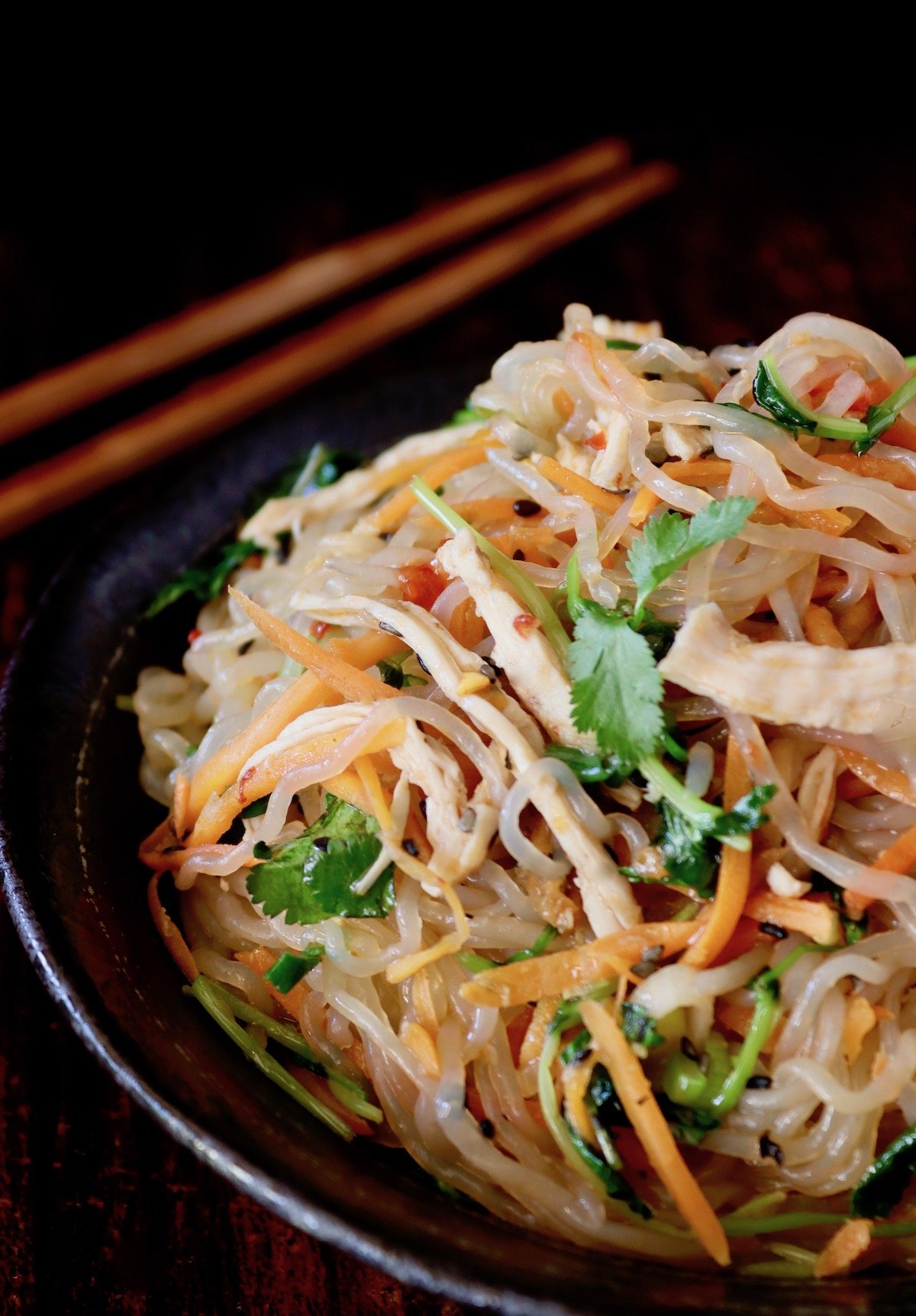
In this recipe, stir-fried Shirataki Noodles are infused with garlic, ginger, a medley of fresh vegetables, all tossed in a mouth-watering sesame-soy sauce that will leave your taste buds wanting more!
The Ingredients
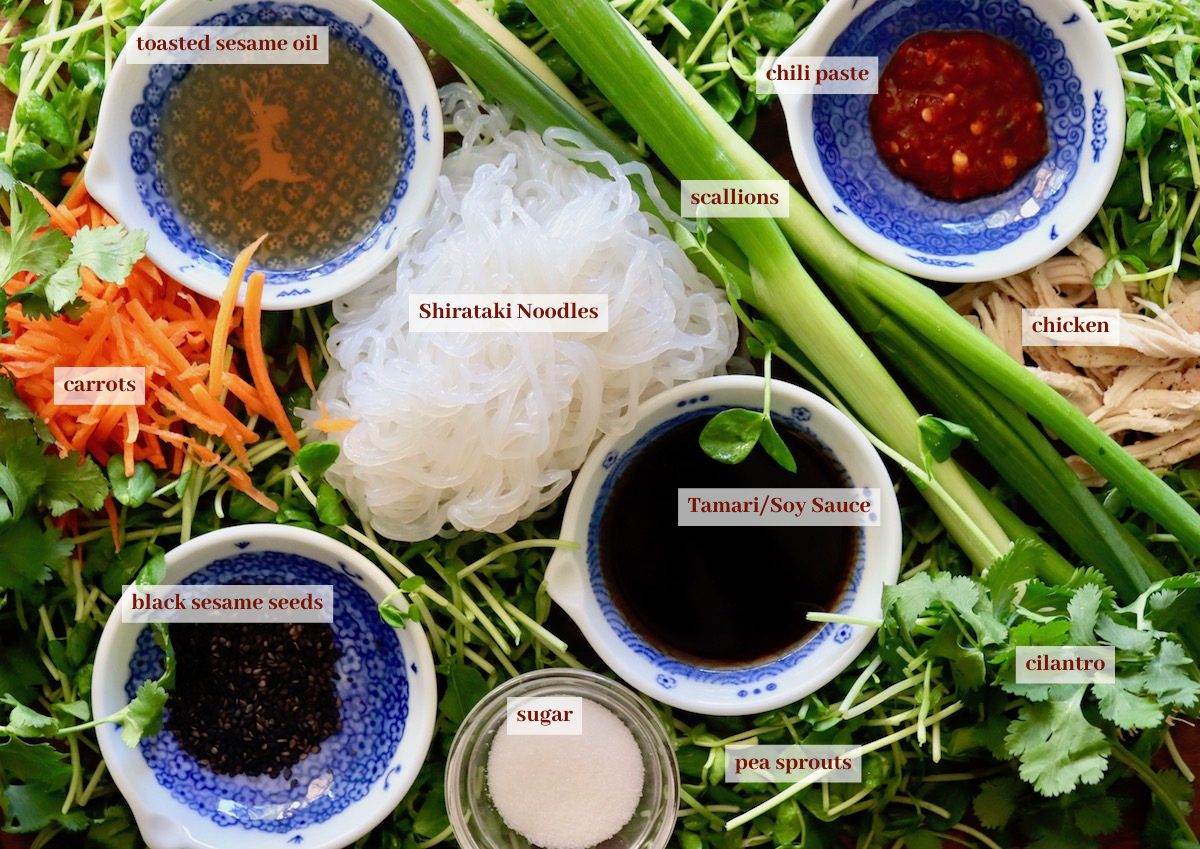
(I often suggest brands I love and use — these are only suggestions and this is not a sponsored post.)
- Shirataki Noodles - They can almost always be found in Asian grocery stores, often in health food stores, and many larger supermarkets are starting to carry them. (Much more information on these noodles below in FAQ.)
- cooked chicken - You can either cook your own chicken or use a cooked Rotisserie chicken.
- neutral oil - Like grapeseed or vegetable.
- carrots - Look for firm, plump carrots, preferably without little roots on the bottom. These will be grated into the stir-fry.
- cilantro - Look for perky bunches and avoid any brown, bruised or yellow leaves.
- pea sprouts - Pea sprouts have a mildly sweet flavor, similar to peas, and they add a very subtle crunch to the stir-fry. Asian markets usually have them, and you should be able to find them in the produce section of most markets, near the bean and alfalfa sprouts.
- fresh garlic - Look for firm heads of garlic without any soft spots or green shoots. (Raw garlic cloves should be firm without any dark spots.)
- fresh ginger - Fresh ginger roots should be firm and feel heavy for their size
- scallions (green onions) - Choose green onion stalks with bright green tops and slightly white bulbs. We'll use both the green and white portions for this stir-fry.
- low-sodium Tamari - Tamari is typically gluten-free. If that's not important to you, low-sodium soy sauce is just as good.
- sesame oil - Toasted sesame oil adds a deeper flavor than regular sesame oil.
- chili paste - This is for a touch of heat. I use Sambal Oelek.
- sugar - Only a touch.
- black sesame seeds - In this recipe the black sesame seeds add to the look of the dish, but you can also use white.
(See recipe card below for quantities.)
Substitutions
- Chicken. The chicken can be replaced with shrimp, fish, steak or tofu.
- Pea sprouts. A few substitutions for pea sprouts are micro greens, bean sprouts, or radish sprouts. You can also use roughly chopped spinach leaves as an alternative.
- Cilantro. My first choice for a cilantro substitution in this recipe is basil. You can also use flat-leaf parsley or roughly chopped arugula.
- Tamari. Note that if you're gluten-free, you should not substitute the Tamari with Soy Sauce unless it specifically says it's gluten-free.
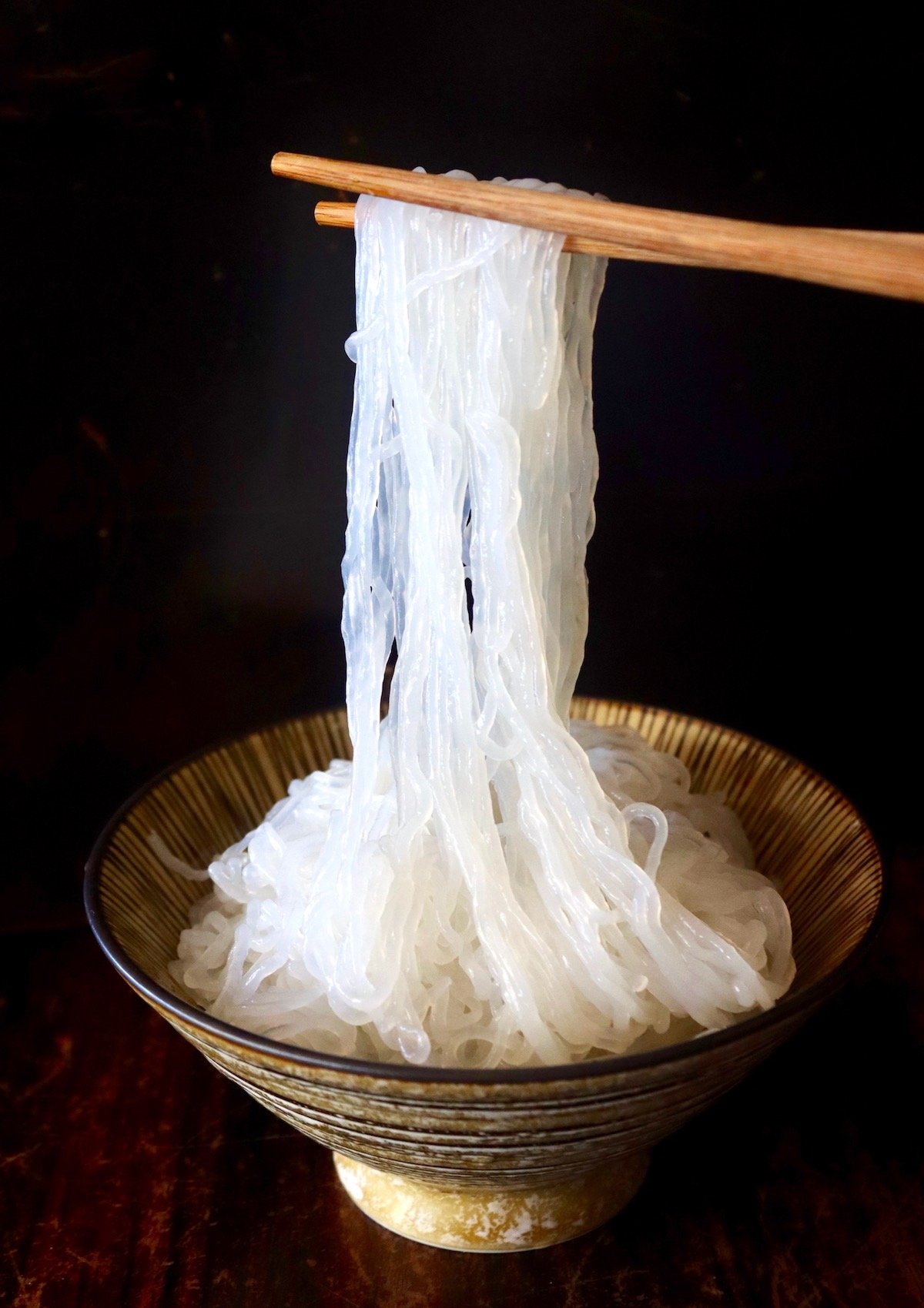
Recipe Tips
- To save time, you can buy pre-grated carrots and a Rotiserrie chicken.
- If you can, grate the fresh garlic and ginger with a microplane zester. This will turn it into a pulp, which will spread its flavor easily, and cling onto the Shirataki Noodles.
- Do not be alarmed by the fishy odor you'll smell when you first open the bag of Shirataki noodles. This is normal and it's easily removed by rinsing and boiling the noodles. (See instruction no. 1 in the recipe card below.)
- The chili paste in this recipe gives it a subtle kick. If you like spicy foods, double the amount listed.
- With the Tamari (or Soy Sauce) and the chili paste, I find salt and pepper aren't necessary, but this is your call. If you want to season to taste, here's how.
How to Make it
- Pour the noodles into a colander and rinse them with cold water. Then add them to a saucepan and add enough water to cover them. Bring the water to a boil, and then reduce the heat to low and simmer for 15 minutes. Drain, rinse, and return them to the saucepan.
- In a small bowl, mix the soy sauce with the sesame oil, chili paste and sugar. Pour this over the noodles, gently toss, cover and set aside.
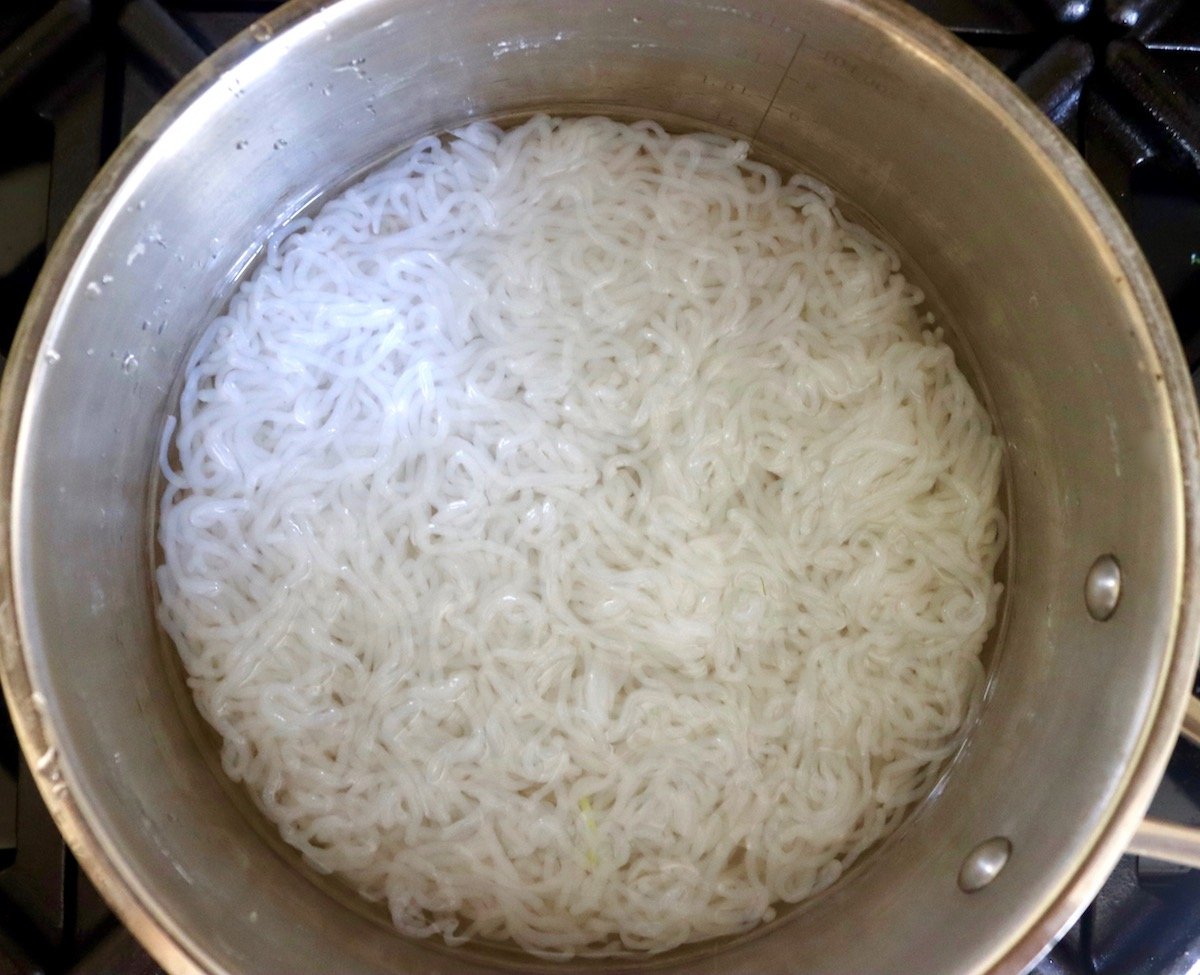
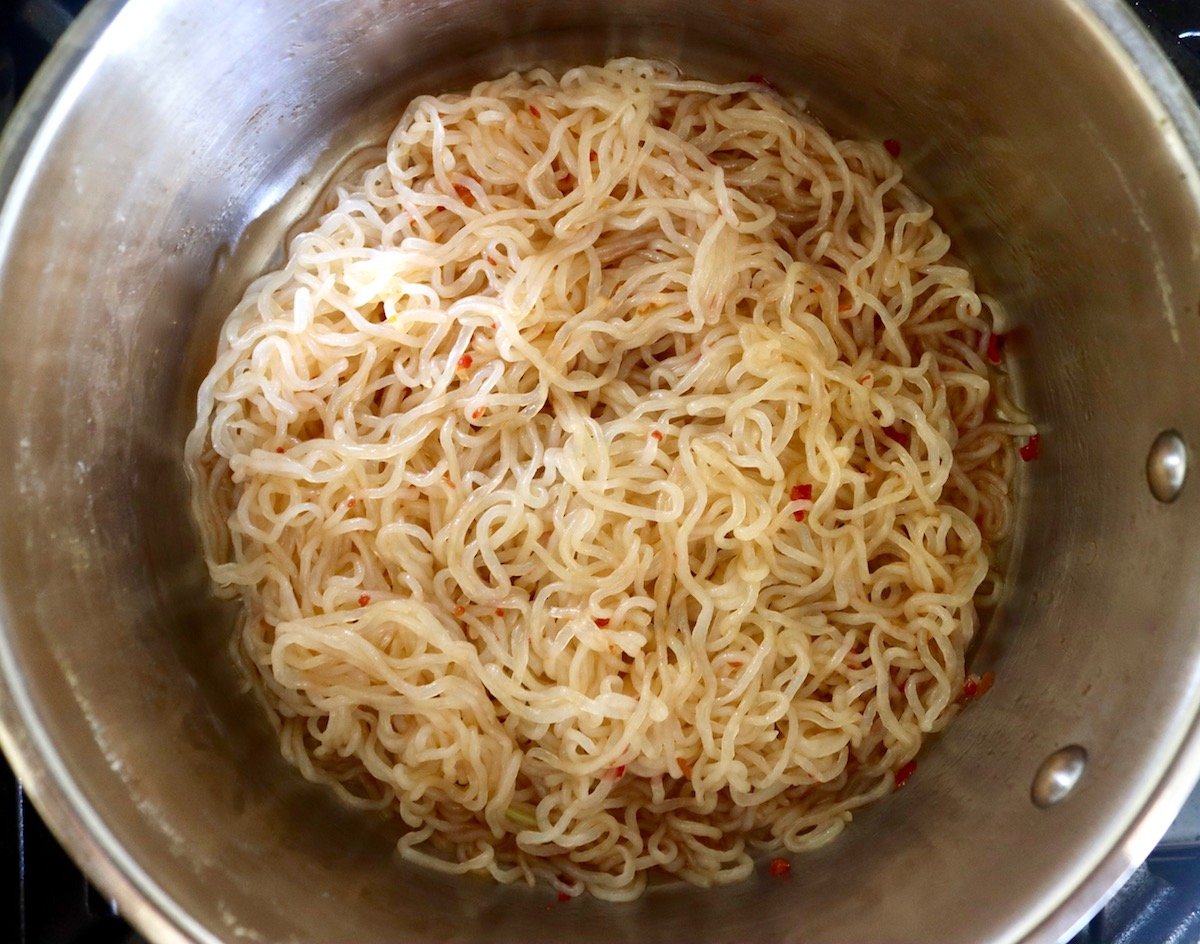
- Lightly coat a sauté pan with oil and place it over medium heat. Add the carrots, pea sprouts, garlic and ginger, and stir to combine. When the carrots are tender, add the cilantro, chicken, scallions and sesame seeds. Stir, cook for about 30 seconds, and turn off the heat.
- Add the noodles to the sauté pan and turn the heat on to low. Gently toss all of the ingredients together, warm and serve.
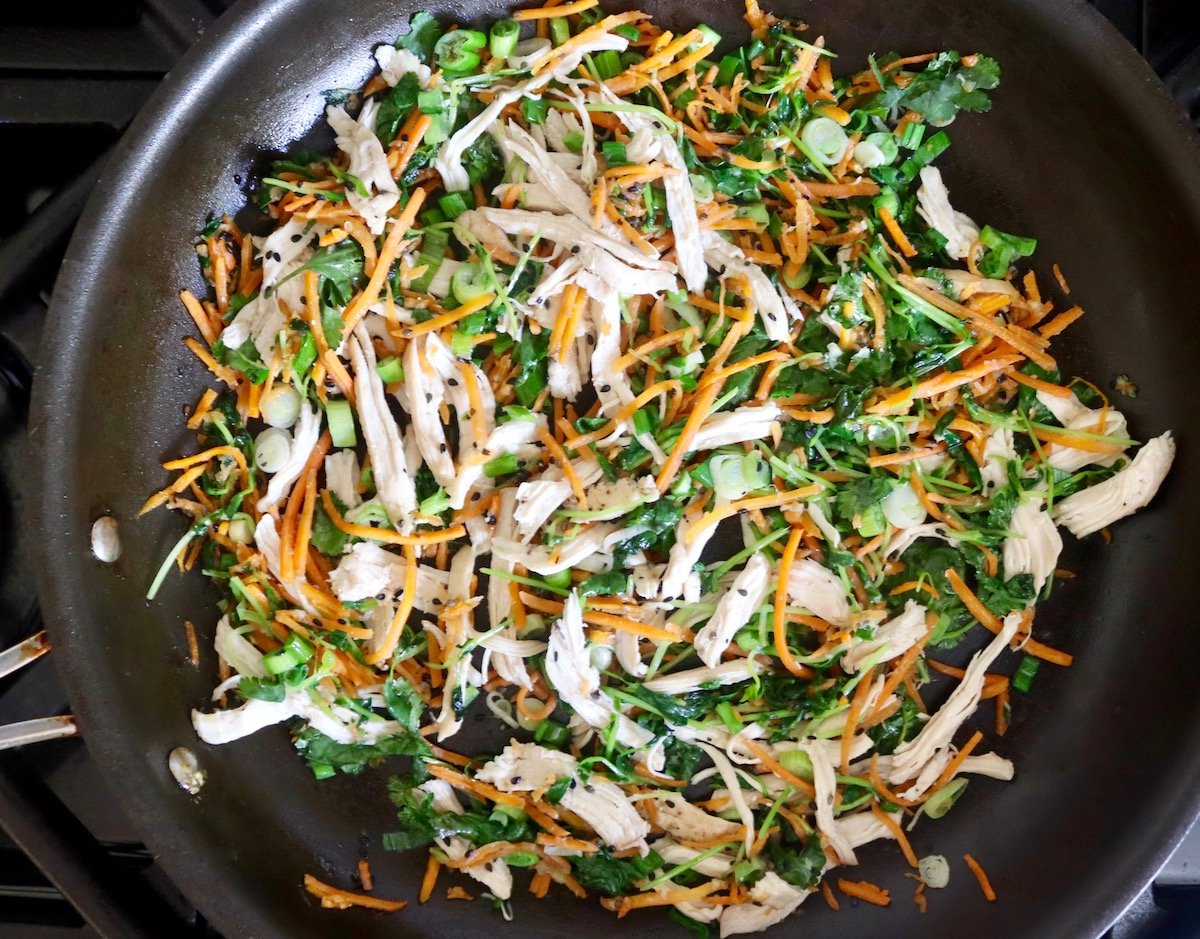
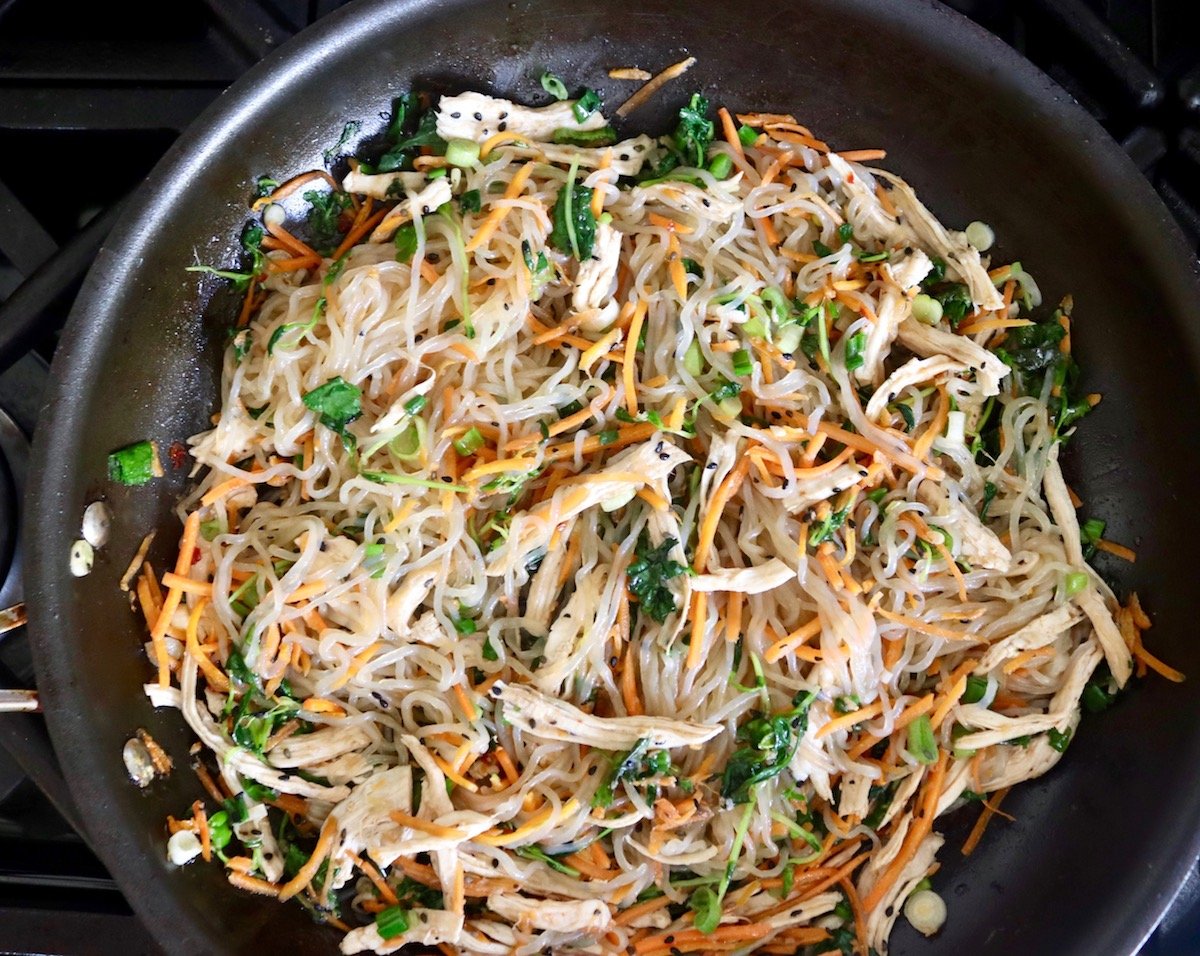
(More detailed instructions are in the recipe card below.)
Serving Suggestions
- Chicken Shirataki Noodle Stir-Fry is quick and easy to prepare, so it's a perfect side or main course for a casual dinner party.
- If you make it without the chicken, you can serve it as a side with steak, fish or chicken. Asian Pear Marinated Steak would be perfect with it!
- And if you want to keep the meal vegetarian, omit the chicken and add a side of Bok Choy with Crispy Garlic or Honey-Sriracha Glazed Broccoli and Tofu. Delicious!
- You can serve this stir-fry cold, warm or hot.
Making it Ahead and Storage
This Shirataki Noodles recipe can be made up to three days ahead of time. With the sauce already incorporated, the noodles don't stick together when they're refrigerated.
Let the noodle dish cool completely and then store in an airtight container in the refrigerator. When you're ready to serve, heat in a pan or microwave just until it's warmed through. (Unless you're serving it cold.)
Variations
Below are a few ideas for other ingredients you can add to the noodles:
- Bok choy, sesame oil, chili oil and toasted sesame seeds.
- Add crispy wontons, tangerines, finely chopped cabbage, and an Asian dressing you love.
- A stir-fry of shiitake mushrooms and spinach would also be great with the noodles.
- You can also totally switch things up from the Asian vibe, and add melted butter, Parmesan and a bit of salt.
FAQ
These super cool, long white, translucent noodles are called Shirataki, Konjac and Miracle. Shirataki is for their appearance, Konjac refers to what they're made of, and Miracle is because their health benefits.
While you can get Shirataki "Spaghetti" Noodles, and Shiratake "Fettucine" Noodles, don't be fooled, they're not one bit Italian -- they're a quintessential Japanese food.
Shirataki Noodles originated in Japan over 1000 years ago. These long white noodles are incredibly versatile in cooking. Since they barley have a flavor of their own, they easily absorb other the flavors of spices, sauces, and juices of all sorts of ingredients.
You can use them as you would Soba or Udon in soups and stir-fries, like the one I'm sharing with chicken and vegetables.
In Japanese Shirataki means white waterfall. If you hold up lots of these white, almost translucent, noodles at once, you can see why they are called this.
Made mostly of water (over 90%!), Shirataki Noodles are also made from the root of a yam-like plant called Konnyaku or Konjac, hence the name Konjac Noodles.
To make the noodles, Glucomannan powder (fiber from the Konjac root) is mixed with water and a little lime water, which helps them hold their shape.
(Some Shirataki Noodles have tofu added to them, which adds calories. If this is important to you, be sure to read the ingredients.)
Yes, they are good for you. Shirataki noodles are gluten-free, fat-free and essentially calorie-free. Without any digestible carbs, the noodles contain traces of calcium, iron and Glucomannan, a fiber made from Konjac root.
The name Miracle Noodles comes from how healthy they are, while they're still filling and can be the main ingredient is so many delicious and hearty recipes.
Here is a more detailed description of the health benefits.
Shirataki noodles can almost always be found in Asian grocery stores and often in health food stores. Additionally, since they're great for a low-carb, gluten-free, vegan, vegetarian and low-fat diets, many supermarkets and large chain stores have started to carry shirataki noodles in their health food or international sections.
You can also purchase them online here.
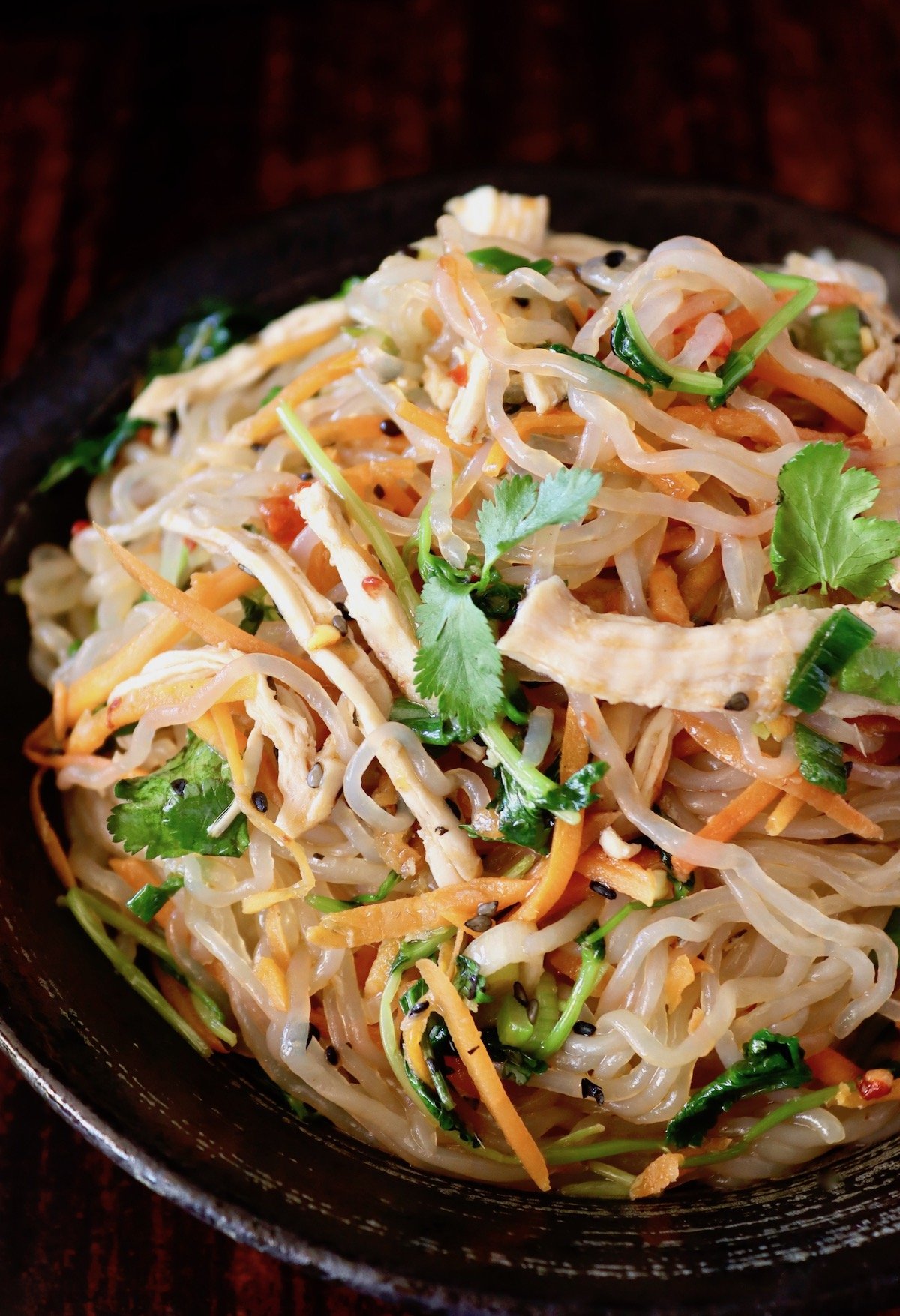
I hope you love this noodle stir-fry as much as my family and I do!
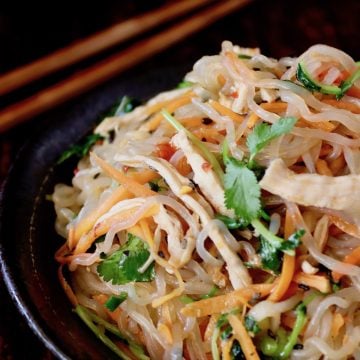
Shirataki Noodle Chicken Stir-Fry Recipe
Equipment
Ingredients
- 1 (14-ounce) package Shirataki Noodles
- 1½ tablespoons low-sodium Tamari or Soy Sauce
- 1½ tablespoon toasted sesame oil
- 1½ teaspoons sugar
- 1 teaspoons chili paste
- grapeseed or vegetable oil for the pan
- 1 cup grated carrots
- 1 cup pea sprouts
- 1 teaspoon garlic pulp
- 1 teaspoon ginger pulp
- ¾ cup cilantro leaves, loosely packed
- ¾ cup cooked chicken, shredded
- ½ cup scallions (white and green portions), thinly sliced
- 1½ teaspoon black sesame seeds, toasted
Instructions
- Prepare the noodles. Open the bag of noodles -- you'll notice a fishy odor, which is normal and is easily removed by rinsing and boiling. Pour the noodles into a colander and rinse them with cold water. Then add them to a saucepan and add enough water to cover them. Bring the water to a boil, and then reduce the heat to low and simmer for 15 minutes. Drain, rinse, and return them to the saucepan. In a small bowl, mix the soy sauce with the sesame oil, chili paste and sugar. Pour this over the noodles and gently toss. Cover and set aside.
- Make the stir-fry. Lightly coat a medium-sized sauté pan with the oil and place it over medium heat. Add the carrots, pea sprouts, garlic and ginger and stir to combine. Sauté until the carrots are tender, about 5 minutes.Add the cilantro, chicken scallions and sesame seeds. Stir, cook for about 30 seconds, and turn off the heat.
- Assemble. Add the noodles to the sauté pan and turn the heat on to low. Gently toss all of the ingredients together. Once everything is warm, remove the pan from the heat and serve.
NOTES
NUTRITION
Cooking On The Weekends is a participant in the Amazon Services LLC Associates Program, an affiliate advertising program designed to provide a means for sites to earn advertising fees by advertising and linking to Amazon.com.


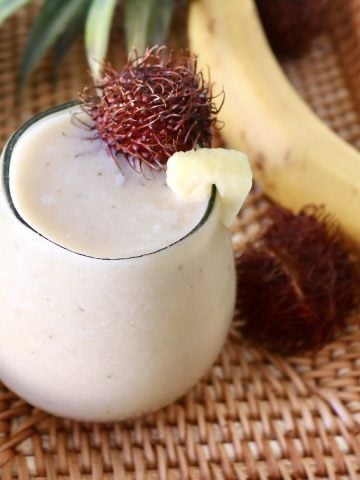


Kim Lange
This dish looks amazing! I can't wait to try!
Valentina
Hope you love it, Kim! Thank you. 🙂 ~Valentina
Jan Harford
I’m going to try this. The subject Miracle Noodles caught my attention. Thanks for posting this recipe.
Valentina
Hi Jan! Thank you, and I hope you love it! 😀 Valentina
Mimi Rippee
I’ve used miracle noodles for years! But I don’t do anything fancy with them. I put them in miso soup, or top them with a red sauce with eggplant. I love what you did here!
Valentina
Hi Mimi, I love adding them to soups! And a red sauce with the eggplant and noodles sounds so comforting and tasty. Enjoy and thanks. 🙂 ~Valentina
David Scott Allen
I have never used or even seen these, but I will look now and try this stir fry soon! We have been making so much Asian food lately — this fits perfectly!
Valentina
Hope you love them, David! They're so good with all sorts of Asian sauces. 🙂 ~Valentina
Eha
Saying hello from Australia variations of your lovely dish are probably the most commin quick meal here - in my kitchen 2-3 times a week certainly1 Most of our ordinary supermarkets would have the noodles tho' sometimes they would be segregated into one of the long Asian shelves. As I do not keep diets I do use ordinary soy plus or minus some oyster sauce . . .
Valentina
Hi Eha, I didn't know these noodles were so popular there. I love that! And so great you can easily get them. I love soy + oyster sauce. Delicious combination -- especially with the noodles. 🙂 ~Valentina
Raymund | angsarap.net
This recipe looks delicious! I'm excited to try it out, especially since it uses Shirataki Noodles, which are low-carb and gluten-free. The combination of garlic, ginger, and sesame-soy sauce sounds mouth-watering, and I appreciate the tips on using pre-grated carrots and a Rotisserie chicken to save time. I'll definitely keep this recipe in mind for a quick and healthy meal. Thank you for sharing!
Valentina
Enjoy, Raymund! Thanks. 🙂 ~Valentina
2pots2cook
Perfect office lunch! Just perfect!
Valentina
Thanks so much, Davorka. Enjoy! 🙂 ~Valentina
Dawn
With all those flavourful ingredients, this must taste so so yummy! Who needs takeout when I can make this at home. Wish I had this for lunch today!!
Valentina
I hope you love it, Dawn. Thanks! 🙂 ~Valentina